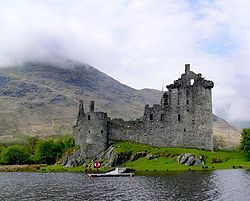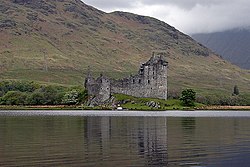Kilchurn Castle
| Kilchurn Castle | |
|
Argyllshire | |
|---|---|
 Kilchurn Castle from the loch | |
| Location | |
| Grid reference: | NN132276 |
| Location: | 56°24’14"N, 5°1’39"W |
| History | |
| Information | |
| Condition: | ruined |
| Owned by: | Historic Scotland |
| Website: | Kilchurn Castle |
Kilchurn Castle is a ruined 15th and 17th century structure on a rocky peninsula at the northeastern end of Loch Awe, in Argyllshire. Access to the Castle is sometimes restricted by higher-than-usual levels of water in the Loch, at which times the site effectively becomes a temporary island.
This was the ancestral home of the Campbells of Glen Orchy, who later became the Earls of Breadalbane also known as the Breadalbane family branch, of the Clan Campbell. The earliest buildings of the castle were the towerhouse and Laich Hall, which looks onto Loch Awe.
History


Kilchurn Castle was built in about 1450 by Sir Colin Campbell, first Lord of Glenorchy, as a five storey tower house with a courtyard defended by an outer wall. By about 1500 an additional range and a hall had been added to the south side of the castle. Further buildings went up during the 16th and 17th centuries. Kilchurn was on a small island in Loch Awe scarcely larger than the castle itself, although it is now connected to the mainland as the water level was altered in 1817. The castle would have been accessed via an underwater or low lying causeway.[1][2]
At the turn of the 16th century Kilchurn Castle was extended by Sir Duncan Campbell with the addition of a single storey dining hall built along the inside of the south curtain. During the second half of the century, another Sir Colin Campbell, the 6th Laird, continued to improve the castle's accommodation by adding some chambers to the north of the tower house, and remodelling the parapet. This included the introduction of the circular corner turrets adorned by corbels, most of which have survived remarkably well.
Towards the end of the 16th century the Clan MacGregor of Glenstrae were occupying the castle. Once owning the lands of Glenorchy during the 14th century, until they passed through marriage to the Campbells, the MacGregors were appointed keepers to Kilchurn Castle as the Campbells spent much of their time at Fincharn. This arrangement lasted until the very early part of the 17th century, when a violent feud between the two families brought it to an end and the Campbells retook possession.
In 1681, Sir John Campbell of Glenorchy was made 1st Earl of Breadalbane. To take advantage of the turbulence of the times, he converted Kilchurn into a modern barracks, capable of housing 200 troops. His main addition was the three storey L-shaped block along the north side.

During the 1715 and 1745 Jacobite risings, the Campbells were stalwarts of the Crown and Kilchurn was used as a Government garrison. The Campbells attempted, unsuccessfully, to sell Kilchurn to the government, after they moved in 1740 to Taymouth Castle in Perthshire.
In 1760, the castle was badly damaged by lightning and was completely abandoned; the remains of a turret of a tower, still resting upside-down in the centre of the courtyard, attest to the violence of the storm.
William Turner's watercolour Midday, painted in 1802, depicts the castle amidst the weather conditions and the geology of Argyll.
The ruin is currently in the care of Historic Scotland, and is open to the public during the summer. Access, during summer only, is by either by boat from Lochawe pier, or on foot from Dalmally. Both points are on the A85 road. During 2006 and 2007 there was an access problem to the castle. Network Rail, in accordance with their policy of blocking foot crossings on railway lines, closed the crossing to Kilchurn, effectively removing land access. However, in 2007 access via the nearby viaduct was created, restoring landward access once more. As of June 2012 - the gates giving access to the level crossing across the railway were open and being used.[3]
Outside links
| ("Wikimedia Commons" has material about Kilchurn Castle) |
- Location map: 56.40361 -5.02889
- Kilchurn Castle - Historic Environment Scotland
- 16th century map of Loch Awe and Kilchurn Castle
References
- ↑ Lindsay, Maurice The Castles of Scotland (1986) Constable London
- ↑ Tranter, Nigel The Fortified House in Scotland. Vol.5, North and West Scotland and miscellaneous Oliver and Boyd/W. & R. Chambers,, EDINBURGH: Date Published: 1962-70. ISBN 978-0-550-21210-8 ISBN 0550212108
- ↑ Property Detail
